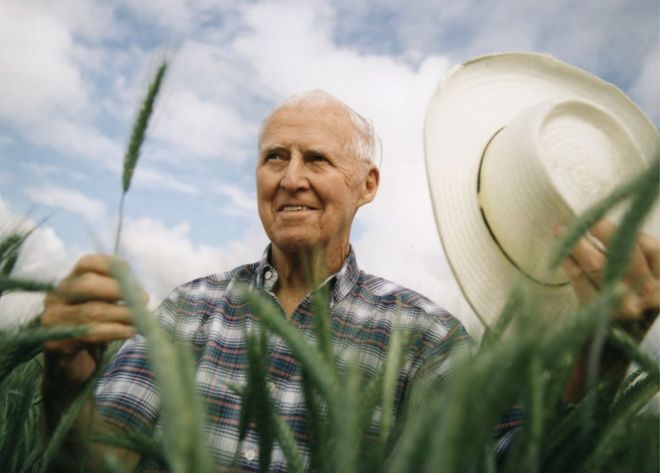Today marks the 10th death anniversary of Dr Norman E Borlaug (1914-2009), a shining star in the history of global food security and mankind, who dreamt and led the Green Revolution. Borlaug sowed an ambitious dream in the solitary wheat field in Mexico in the 1940s and harvested the Green Revolution in late 1960s.
He appeared as a visionary leader with a gigantic dream to end hunger. A universal war was launched silently against hunger with scientific approach, innovation, dream and leadership. The miraculous high yielding semi-dwarf wheat variety was developed with two decades of rigorous hybridisation. This promising variety was popularly named as “miracle wheat” for its miracle yield potential and disease resistance. Exploiting the same research protocol, high yielding rice varieties were developed within a few years in South Asia.
The spectacular increase in wheat and rice production from 1965 to 1969 brought about a revolution in global food production. Wheat yield increased by 4 to 5 times in Mexico. By 1969 more than 50 percent of total wheat area in India and Pakistan came under Mexican semi-dwarf variety. These two countries harvested more than double production in 1969 compared to 1964. Afghanistan, Indonesia, Kenya, Philippines, Thailand, Malaysia, Morocco, Iran and Turkey responded very quickly to the new wheat varieties.
Borlaug, a former wrestler in Minnesota University, was awarded the Noble Peace Prize in 1970 by the Norwegian Nobel Committee in recognition of his ground-breaking contribution in pioneering the Green Revolution. Borlaug came to be known as the “Father of the Green Revolution”. Besides, he was awarded the prestigious Congressional Medal and Presidential Medal of Freedom by the United States, India’s Padma Vibhushan award and dozens of other accolades and honorary doctorate degrees.
Green Revolution in the 1960s was indeed a great milestone for human civilisation. After WWII Malthusian economists predicted serious consequences for humankind due to the burgeoning population throughout the world. Global unrest and widespread hunger were predicted due to shortage of food. Global peace was feared to be destabilised by hunger, poverty and human misery. Before the Green Revolution, the per capita availability of cereals was less than 300 g per day, it is currently more than 1,000 g.
The golden rays of the Green Revolution touched the soil of Bangladesh immediately after its liberation in 1971. Bangabandhu Sheikh Mujibur Rahman responded to the Green Revolution very quickly and appealed for an agricultural revolution in the new-born country.
The government of Bangabandhu Sheikh Mujibur Rahman attached the highest priority to agricultural development. During Bangabandhu’s rule, Bangladesh Agricultural Research Council, Bangladesh Rice Research Institute, Bangladesh Agricultural Research Institute, Cotton Development Board, Horticulture Board and other necessary infrastructure were established. Farmer-friendly agriculture policies were formulated. All out support was provided to farmers. Norman Borlaug visited Bangladesh in 1999 and Bangladesh Agricultural University awarded him an honorary doctorate degree.
Borlaug devoted his life to his dream to achieve and promote food security and sustainable agriculture. At the end of his life he was happy with the status of food availability in the world, but he was also very concerned about the unabated chemical aggression, sick trade war, distorted market, widespread pollution, endangered biodiversity and threatening carbon issue. He cherished a lifelong dream for an “Evergreen Revolution” for sustainability, peace and stability.
The reality of the 1960s and 2010s are not of the same severity and dimension. In 1960s, low productivity in agriculture was the biggest concern, while sustainability, green issues and climatic change have become the key challenges for the present world. We must address these grave global issues with green innovations, technologies and policies. We must put all our efforts to move towards a sustainable Evergreen Revolution.
Agriculture in coming years is going to be much more challenging than ever before due to climate change, declining natural resources and distorted market policy. Currently, around one billion people (16 percent of the global population) suffer from chronic hunger at a time when there is more than enough food to feed everyone on the planet. Recent studies suggest that in order to feed 9 billion people, the world will need 70 to 100 percent more food by 2050.
We should not rely on yield increase only to ensure food security. Borlaug shed light on changing diet, reducing waste, crop intensification and expanding aquaculture. We have enough technologies in our hands to fight against hunger; however, to address the food security challenges in the coming days, the world needs a visionary leader, a dreamer, a change maker like Borlaug, who will lead the fourth generation (4G) agricultural revolution with sustainability, equity and justice. We hope that the United Nations as well as other international organisations will play leading roles to sustain global food security.
Borlaug is still an eternal source of inspiration, even in the age of Precision Agriculture, Genetic Engineering and Conservation Farming. His revolutionary spirit and vision need to be shared from generation to generation for the welfare of mankind. Let us carry forward the legacy of the Father of the Green Revolution into the future.



